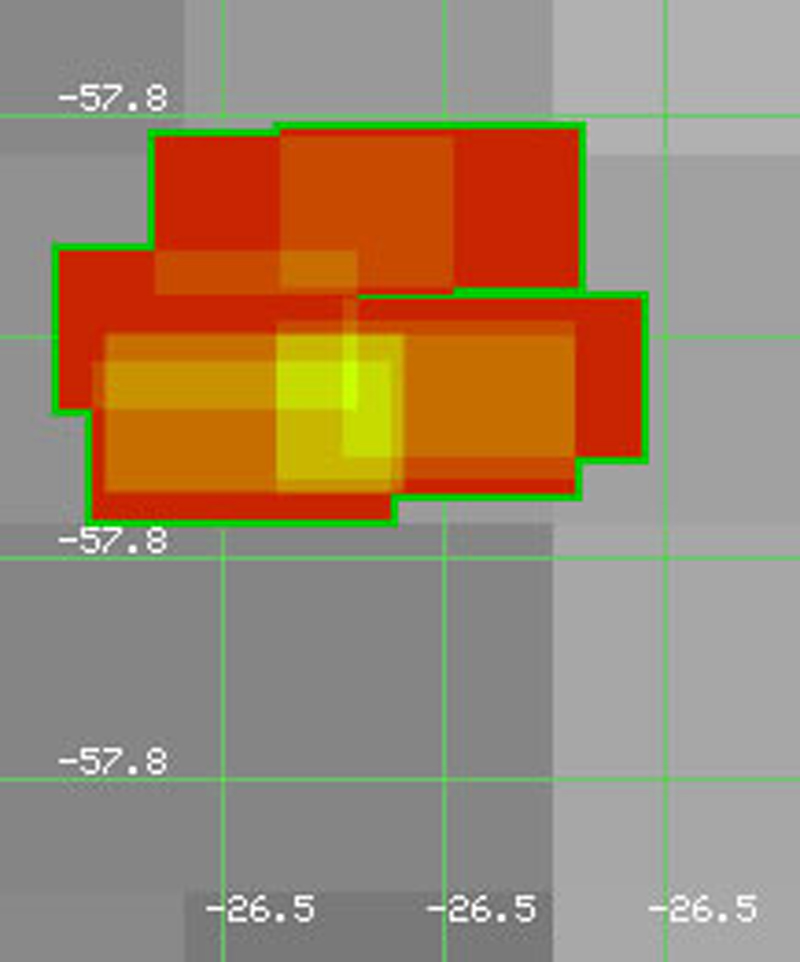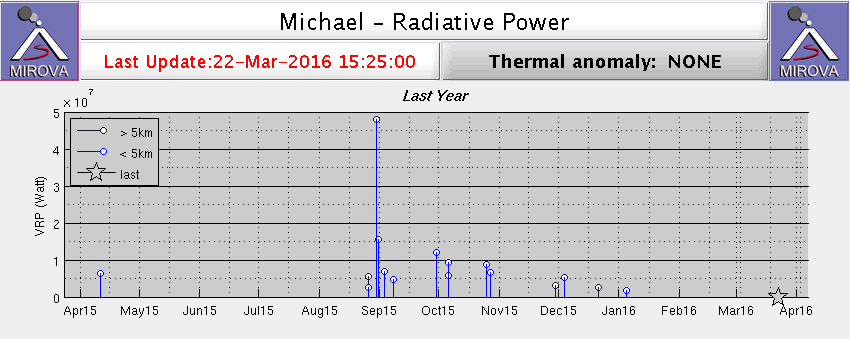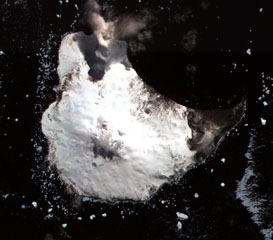Report on Saunders (United Kingdom) — February 2016
Bulletin of the Global Volcanism Network, vol. 41, no. 2 (February 2016)
Managing Editor: Edward Venzke.
Research and preparation by Robert Andrews.
Saunders (United Kingdom) Thermal anomalies during August-October 2015
Please cite this report as:
Global Volcanism Program, 2016. Report on Saunders (United Kingdom) (Venzke, E., ed.). Bulletin of the Global Volcanism Network, 41:2. Smithsonian Institution. https://doi.org/10.5479/si.GVP.BGVN201602-390090
Saunders
United Kingdom
57.8°S, 26.483°W; summit elev. 843 m
All times are local (unless otherwise noted)
The Michael stratovolcano forms the emergent small, unpopulated, mostly ice-covered Saunders Island, part of the South Sandwich Islands. The volcano is primarily monitored using satellite imagery. Prior to August 2015, the most recent eruptive activity detected was in the second half of 2012 (BGVN 38:02).
Infrared MODIS satellite data processed by MODVOLC showed thermal alerts at the summit of Michael during 28 August to 8 October 2015 (figure 9, table 4). MODIS data presented on the MIROVA site shows increased radiative power (measured from satellite thermal data) from late August through October 2015, with a very strong maximum near the end of August (figure 10); lower-power gradually decreasing detections during late November 2015-January 2016 may represent a cooling lava flow. It should be noted that cloud cover over a volcano may prevent the measurement of infrared data.
 |
Figure 9. MODVOLC map of measured thermal alerts (each colored rectangle represents a pixel) during 28 August through 8 October 2015. Courtesy of MODVOLC. |
Table 4. Satellite thermal alerts measured by MODVOLC over Michael during August-October 2015. Pixel sizes generally range from 1-1.5 km2. Courtesy of MODVOLC.
| Date | Time (UTC) | Number of pixels | Satellite |
| 28 Aug 2015 | 0050 | 1 | Terra |
| 28 Aug 2015 | 0235 | 1 | Aqua |
| 30 Aug 2015 | 0225 | 1 | Aqua |
| 31 Aug 2015 | 0120 | 1 | Terra |
| 30 Sep 2015 | 0130 | 1 | Terra |
| 02 Oct 2015 | 0120 | 2 | Terra |
| 06 Oct 2015 | 1610 | 1 | Aqua |
| 08 Oct 2015 | 1660 | 1 | Aqua |
 |
Figure 10. MIROVA graph showing radiative power measured by satellite over Michael during April 2015 to April 2016, with a strong maximum on the last day of August 2015. Courtesy of MIROVA. |
Geological Summary. Saunders Island consists of a large central volcanic edifice intersected by two seamount chains, as shown by bathymetric mapping (Leat et al., 2013). The young Mount Michael stratovolcano dominates the glacier-covered island, while two submarine plateaus, Harpers Bank and Saunders Bank, extend north. The symmetrical Michael has a 500-m-wide summit crater and a remnant of a somma rim to the SE. Tephra layers visible in ice cliffs surrounding the island are evidence of recent eruptions. Ash clouds were reported from the summit crater in 1819, and an effusive eruption was inferred to have occurred from a N-flank fissure around the end of the 19th century and beginning of the 20th century. A low ice-free lava platform, Blackstone Plain, is located on the north coast, surrounding a group of former sea stacks. A cluster of cones on the SE flank, the Ashen Hills, appear to have been modified since 1820 (LeMasurier and Thomson, 1990). Analysis of satellite imagery available since 1989 (Gray et al., 2019; MODVOLC) suggests frequent eruptive activity (when weather conditions allow), volcanic clouds, steam plumes, and thermal anomalies indicative of a persistent, or at least frequently active, lava lake in the summit crater. Due to this observational bias, there has been a presumption when defining eruptive periods that activity has been ongoing unless there is no evidence for at least 10 months.
Information Contacts: MIROVA, a collaborative project between the Universities of Turin and Florence (Italy) supported by the Centre for Volcanic Risk of the Italian Civil Protection Department (URL: http://www.mirovaweb.it/); Hawai'i Institute of Geophysics and Planetology (HIGP), MODVOLC Thermal Alerts System, School of Ocean and Earth Science and Technology (SOEST), Univ. of Hawai'i, 2525 Correa Road, Honolulu, HI 96822, USA (URL: http://modis.higp.hawaii.edu/)

